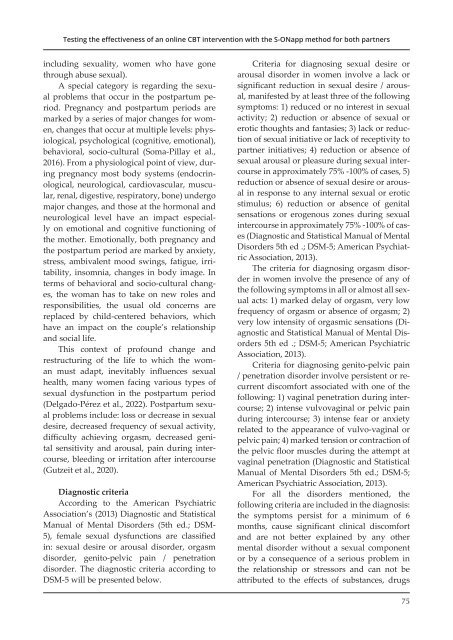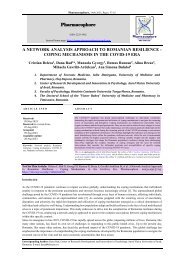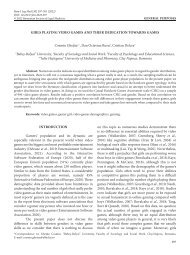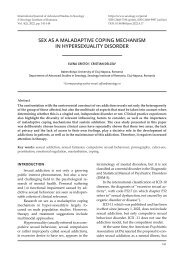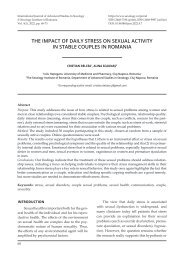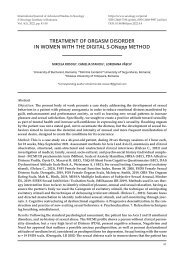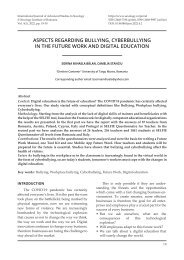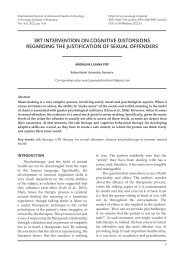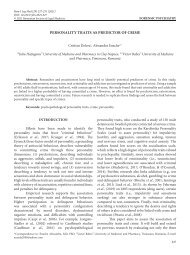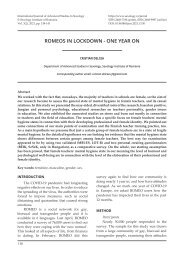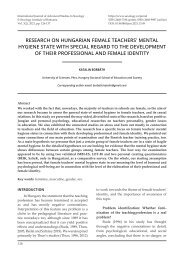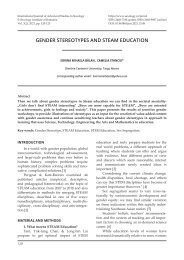Testing the effectiveness of an online CBT intervention with the S-ONapp method for both partners to reduce postpartum female sexual disorders
Objective: The research evaluates the effectiveness of an online CBT program through the S-ONapp method addressed to both partners in order to decrease female sexual problems and increase the sexual satisfaction of both partners in the postpartum period. Method: In a randomized clinical trial, participants - women in the first 3 months postpartum with sexual problems revealed by FSFI scale scores - were randomly assigned to two groups: experimental group (CBT online intervention for both partners) and control group (intervention CBT online standard for women). For both groups, scores on the FSFI (female sexual disorder), NSSS-S (sexual satisfaction) scales for both partners, and DAS (couple satisfaction) scales for both partners are measured on pretest, posttest, and 6-month follow-up. Expected results: Regarding the control group, we expect that in the experimental group there will be: 1) a lower level of postpartum sexual problems reported by women in the posttest; 2) a higher level of sexual satisfaction reported by women in the posttest; 3) a higher level of sexual satisfaction reported by partners in the posttest; 4) a higher level of couple satisfaction reported by women in the posttest; 5) a higher level of couple satisfaction reported by partners in the posttest. The results are maintained 6 months after the intervention. Conclusions: An online CBT intervention program for both partners, based on a multidimensional approach to postpartum female sexual problems, is effective in improving the sexual life of both partners by increasing sexual satisfaction and couple satisfaction, with direct implications for the clinical field.
Objective: The research evaluates the effectiveness of an online CBT program through the S-ONapp
method addressed to both partners in order to decrease female sexual problems and increase the sexual satisfaction of both partners in the postpartum period. Method: In a randomized clinical trial, participants - women in the first 3 months postpartum with sexual problems revealed by FSFI scale scores - were randomly assigned to two groups: experimental group (CBT online intervention for both partners) and control group (intervention CBT online standard for women). For both groups, scores on the FSFI (female sexual disorder), NSSS-S (sexual satisfaction) scales for both partners, and DAS (couple satisfaction) scales for both partners are measured on pretest, posttest, and 6-month follow-up.
Expected results: Regarding the control group, we expect that in the experimental group there will be:
1) a lower level of postpartum sexual problems reported by women in the posttest; 2) a higher level of
sexual satisfaction reported by women in the posttest; 3) a higher level of sexual satisfaction reported
by partners in the posttest; 4) a higher level of couple satisfaction reported by women in the posttest;
5) a higher level of couple satisfaction reported by partners in the posttest. The results are maintained
6 months after the intervention.
Conclusions: An online CBT intervention program for both partners, based on a multidimensional
approach to postpartum female sexual problems, is effective in improving the sexual life of both partners by increasing sexual satisfaction and couple satisfaction, with direct implications for the clinical field.
Create successful ePaper yourself
Turn your PDF publications into a flip-book with our unique Google optimized e-Paper software.
<strong>Testing</strong> <strong>the</strong> <strong>effectiveness</strong> <strong>of</strong> <strong>an</strong> <strong>online</strong> <strong>CBT</strong> <strong>intervention</strong> <strong>with</strong> <strong>the</strong> S-<strong>ONapp</strong> <strong>method</strong> <strong>for</strong> <strong>both</strong> <strong>partners</strong><br />
including <strong>sexual</strong>ity, women who have gone<br />
through abuse <strong>sexual</strong>).<br />
A special category is regarding <strong>the</strong> <strong>sexual</strong><br />
problems that occur in <strong>the</strong> <strong>postpartum</strong> period.<br />
Pregn<strong>an</strong>cy <strong>an</strong>d <strong>postpartum</strong> periods are<br />
marked by a series <strong>of</strong> major ch<strong>an</strong>ges <strong>for</strong> women,<br />
ch<strong>an</strong>ges that occur at multiple levels: physiological,<br />
psychological (cognitive, emotional),<br />
behavioral, socio-cultural (Soma-Pillay et al.,<br />
2016). From a physiological point <strong>of</strong> view, during<br />
pregn<strong>an</strong>cy most body systems (endocrinological,<br />
neurological, cardiovascular, muscular,<br />
renal, digestive, respira<strong>to</strong>ry, bone) undergo<br />
major ch<strong>an</strong>ges, <strong>an</strong>d those at <strong>the</strong> hormonal <strong>an</strong>d<br />
neurological level have <strong>an</strong> impact especially<br />
on emotional <strong>an</strong>d cognitive functioning <strong>of</strong><br />
<strong>the</strong> mo<strong>the</strong>r. Emotionally, <strong>both</strong> pregn<strong>an</strong>cy <strong>an</strong>d<br />
<strong>the</strong> <strong>postpartum</strong> period are marked by <strong>an</strong>xiety,<br />
stress, ambivalent mood swings, fatigue, irritability,<br />
insomnia, ch<strong>an</strong>ges in body image. In<br />
terms <strong>of</strong> behavioral <strong>an</strong>d socio-cultural ch<strong>an</strong>ges,<br />
<strong>the</strong> wom<strong>an</strong> has <strong>to</strong> take on new roles <strong>an</strong>d<br />
responsibilities, <strong>the</strong> usual old concerns are<br />
replaced by child-centered behaviors, which<br />
have <strong>an</strong> impact on <strong>the</strong> couple’s relationship<br />
<strong>an</strong>d social life.<br />
This context <strong>of</strong> pr<strong>of</strong>ound ch<strong>an</strong>ge <strong>an</strong>d<br />
restructuring <strong>of</strong> <strong>the</strong> life <strong>to</strong> which <strong>the</strong> wom<strong>an</strong><br />
must adapt, inevitably influences <strong>sexual</strong><br />
health, m<strong>an</strong>y women facing various types <strong>of</strong><br />
<strong>sexual</strong> dysfunction in <strong>the</strong> <strong>postpartum</strong> period<br />
(Delgado-Pérez et al., 2022). Postpartum <strong>sexual</strong><br />
problems include: loss or decrease in <strong>sexual</strong><br />
desire, decreased frequency <strong>of</strong> <strong>sexual</strong> activity,<br />
difficulty achieving orgasm, decreased genital<br />
sensitivity <strong>an</strong>d arousal, pain during intercourse,<br />
bleeding or irritation after intercourse<br />
(Gutzeit et al., 2020).<br />
Diagnostic criteria<br />
According <strong>to</strong> <strong>the</strong> Americ<strong>an</strong> Psychiatric<br />
Association’s (2013) Diagnostic <strong>an</strong>d Statistical<br />
M<strong>an</strong>ual <strong>of</strong> Mental Disorders (5th ed.; DSM-<br />
5), <strong>female</strong> <strong>sexual</strong> dysfunctions are classified<br />
in: <strong>sexual</strong> desire or arousal disorder, orgasm<br />
disorder, geni<strong>to</strong>-pelvic pain / penetration<br />
disorder. The diagnostic criteria according <strong>to</strong><br />
DSM-5 will be presented below.<br />
Criteria <strong>for</strong> diagnosing <strong>sexual</strong> desire or<br />
arousal disorder in women involve a lack or<br />
signific<strong>an</strong>t reduction in <strong>sexual</strong> desire / arousal,<br />
m<strong>an</strong>ifested by at least three <strong>of</strong> <strong>the</strong> following<br />
symp<strong>to</strong>ms: 1) <strong>reduce</strong>d or no interest in <strong>sexual</strong><br />
activity; 2) reduction or absence <strong>of</strong> <strong>sexual</strong> or<br />
erotic thoughts <strong>an</strong>d f<strong>an</strong>tasies; 3) lack or reduction<br />
<strong>of</strong> <strong>sexual</strong> initiative or lack <strong>of</strong> receptivity <strong>to</strong><br />
partner initiatives; 4) reduction or absence <strong>of</strong><br />
<strong>sexual</strong> arousal or pleasure during <strong>sexual</strong> intercourse<br />
in approximately 75% -100% <strong>of</strong> cases, 5)<br />
reduction or absence <strong>of</strong> <strong>sexual</strong> desire or arousal<br />
in response <strong>to</strong> <strong>an</strong>y internal <strong>sexual</strong> or erotic<br />
stimulus; 6) reduction or absence <strong>of</strong> genital<br />
sensations or erogenous zones during <strong>sexual</strong><br />
intercourse in approximately 75% -100% <strong>of</strong> cases<br />
(Diagnostic <strong>an</strong>d Statistical M<strong>an</strong>ual <strong>of</strong> Mental<br />
Disorders 5th ed .; DSM-5; Americ<strong>an</strong> Psychiatric<br />
Association, 2013).<br />
The criteria <strong>for</strong> diagnosing orgasm disorder<br />
in women involve <strong>the</strong> presence <strong>of</strong> <strong>an</strong>y <strong>of</strong><br />
<strong>the</strong> following symp<strong>to</strong>ms in all or almost all <strong>sexual</strong><br />
acts: 1) marked delay <strong>of</strong> orgasm, very low<br />
frequency <strong>of</strong> orgasm or absence <strong>of</strong> orgasm; 2)<br />
very low intensity <strong>of</strong> orgasmic sensations (Diagnostic<br />
<strong>an</strong>d Statistical M<strong>an</strong>ual <strong>of</strong> Mental Disorders<br />
5th ed .; DSM-5; Americ<strong>an</strong> Psychiatric<br />
Association, 2013).<br />
Criteria <strong>for</strong> diagnosing geni<strong>to</strong>-pelvic pain<br />
/ penetration disorder involve persistent or recurrent<br />
discom<strong>for</strong>t associated <strong>with</strong> one <strong>of</strong> <strong>the</strong><br />
following: 1) vaginal penetration during intercourse;<br />
2) intense vulvovaginal or pelvic pain<br />
during intercourse; 3) intense fear or <strong>an</strong>xiety<br />
related <strong>to</strong> <strong>the</strong> appear<strong>an</strong>ce <strong>of</strong> vulvo-vaginal or<br />
pelvic pain; 4) marked tension or contraction <strong>of</strong><br />
<strong>the</strong> pelvic floor muscles during <strong>the</strong> attempt at<br />
vaginal penetration (Diagnostic <strong>an</strong>d Statistical<br />
M<strong>an</strong>ual <strong>of</strong> Mental Disorders 5th ed.; DSM-5;<br />
Americ<strong>an</strong> Psychiatric Association, 2013).<br />
For all <strong>the</strong> <strong>disorders</strong> mentioned, <strong>the</strong><br />
following criteria are included in <strong>the</strong> diagnosis:<br />
<strong>the</strong> symp<strong>to</strong>ms persist <strong>for</strong> a minimum <strong>of</strong> 6<br />
months, cause signific<strong>an</strong>t clinical discom<strong>for</strong>t<br />
<strong>an</strong>d are not better explained by <strong>an</strong>y o<strong>the</strong>r<br />
mental disorder <strong>with</strong>out a <strong>sexual</strong> component<br />
or by a consequence <strong>of</strong> a serious problem in<br />
<strong>the</strong> relationship or stressors <strong>an</strong>d c<strong>an</strong> not be<br />
attributed <strong>to</strong> <strong>the</strong> effects <strong>of</strong> subst<strong>an</strong>ces, drugs<br />
75


